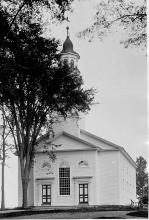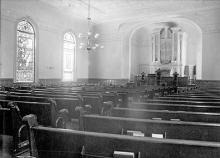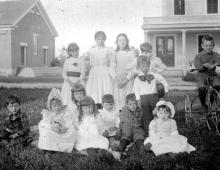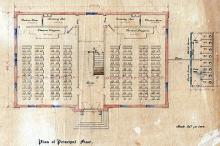Life in the Maritime Community

Sometimes life in a maritime community offered unusual opportunities. The wife of a master mariner had more options than most other 19th century women. She could choose to go to sea with her husband or remain behind. (Life aboard 19th century sailing vessels is discussed in our chapter Life at Sea and in the chapters Stories of the Sea: the Searsport Sea Captains and Women's Roles.) Wives of merchant captains were important in linking sea and shore, and they played a major role in establishing a sense of community aboard ship.
Wives who stayed ashore were expected to manage the family and her husband’s business affairs, as well as maintaining community social networks. A woman whose husband was gone for long periods probably had to depend on credit from storekeepers, as her husband’s wages would be sent home only sporadically. Lack of communication from ship to home could be stressful for both husbands and wives. When the seafarer returned home, roles were expected to shift—wives had to relinquish control of family matters to their husbands, who were used to command at sea.
The 19th century brought changes in the structure of family life. Arranged marriages were common early in this period, but by 1900 people generally chose their spouses. The birth rate dropped from an average of 7 children at the beginning of the century to 3-4 by the end. As industrialization resulted in less domestic work, fewer hours and fewer people were required to keep the household going, and it was expected that more attention be paid to each child in the family. Single women began to work, perhaps doing piece work Piece work piecework
In the early days of factory-made clothing, workers were paid by the pieces produced. in the garment industry. Many single women migrated to mill towns.
Diversity, Social Welfare, Religion
Social welfare developed early in Maine’s maritime communities—Portland founded a Marine Society in 1796 to care for widows and orphans of mariners, and by 1828 the town had 28 different charitable organizations. Wiscasset had a Female Charitable Society in 1805. In towns all along the coast, charity was an important community tradition.
Religion was important in the structure of daily life, families, towns, social relationships, culture and education. Congregationalism Congregationalism
A form of Protestant church government in which each local religious society is independent and self-governing was state supported, in a sense, because the Congregational Church controlled the tax money that was set aside in each town for religion. Later, Baptists, Methodists, and small numbers of Catholics, AnglicansAnglican
Of or characteristic of the Church of England or any of the churches related to it, such as the Episcopal Church., QuakersQuaker
A member of the Religious Society of Friends. The Quakers are a group of Christians who use no scripture and believe in great simplicity in daily life and in worship. Their services consist mainly of silent meditation., ShakersShaker
A member of the Millennial Church, originating in England in the middle of the 18th century and brought to the U.S. in 1774, advocating celibacy, common ownership of property, and a strict and simple way of life: so called from their practice of shaking during religious services., and Unitarians Unitarian
A member of a liberal religious denomination founded upon the doctrine that God is one being, and giving each congregation complete control over its affairs. began to arrive in Maine.
Maine’s population in the 19th century was primarily of English and Scottish descent, with scattered enclaves of Irish, Swedish, and German immigrants, and a few African Americans. Island granite quarries were manned by Finns, Swedes, and Italians. In the 1840s many Irish came to work in the mills, and French Canadian workers arrived in the 1860s, but these new arrivals gravitated to larger cities in Maine. Coastal towns remained exceptionally homogeneous.
By the end of the 19th century most of Maine’s Native American population lived in scattered family bands and in small communities, primarily Indian Island (Penobscot) and Pleasant Point (Passamaquoddy.)
Medical care
Medical care was usually home grown early in the century, and in fact doctors at that time often were forced to supplement their occupation with other work. Babies were delivered by midwivesMidwife
In the past, a woman trained to deliver babies; now a nursing specialty requiring advanced education. . (At sea the Captain sometimes had to deliver his own child, although a Searsport midwife, Grandma Searles, sometimes sailed with pregnant women.) In 1820 the Maine Medical School in Brunswick began to train doctors, so that by mid-century even small coastal towns had doctors who made house calls at any hour.
Domestic skills
In the early 19th century women spun their own flax (linen), wool, and imported cotton into yarn, then wove it into homespun cloth. Towns with water power had mills for carding Carding
Cleansing and disentangling fibers prior to spinning, using stiff brush-like surfaces on cards. or fulling Fulling
To shrink and thicken woolen cloth by moistening, heating, and pressing. cloth. Until the 1830s, when shops began to sell men’s ready-made garments, clothing was made at home. Itinerant cobblers made shoes and boots, and later a shoe industry developed in Maine, using by-products of the lumber industry.
Education
In 1800, Maine had 161 incorporated towns, and all had free common schools; however, only seven provided grammar schools Grammar schools
In the nineteenth century, schools that offered instruction beyond the elementary level. Grammar schools could be attended only by children whose parents owned shares in the school. which offered instruction beyond the elementary level. Grammar schools could be attended only by children whose parents owned shares in the school. Despite Portland’s standing as the largest city in Maine at the beginning of the 19th century, other towns, including Hallowell, Berwick, East Machias, and Fryeburg opened grammar schools or academies before Portland. There were also private boarding schools for boys run by ministers, and dame schools Dame School
Private elementary school taught by women generally in their home. Dame schools were open to girls in colonial times, while publicly supported grammar schools were only for boys. for very young children and girls. In 1816, a female academy opened in Augusta, and in 1821 Portland opened Maine’s first (the nation’s second) free high school. Maine’s female academies often included celestial navigation Celestial navigation
Using the sun, moon, stars, and planets to find your location. in their curriculum. Maine began to provide financial support for education in 1828.
Newspapers
Maine established 31 newspapers between 1785 and 1820, and most were in coastal and river towns. In those early days, newspapers carried mostly national and international news. Penobscot Marine Museum has copies of the Republican Journal back to the nineteenth century. Reading material was valued—papers and books were shared and saved in coastal Maine. As early as 1800, there was a library in the maritime community of Wiscasset.
Recreation
In Maine’s maritime communities ship launchings were important social events including flags, bells, and pig roasts. Other work-related gatherings, or “bees,” accomplished quilting, apple paring, corn husking, and barn raising.
Maine’s professional and merchant families enjoyed dances, parties, and games, as well as reading, letter writing, keeping journals, drawing, painting, and needlework. Belfast held dances at the local tavern, and dancing schools were popular, as was singing in parts at someone’s home.
The Fourth of July was a major holiday in 19th century Maine. It included speeches, cannons, parades, picnics, and sit-down dinners for men, who used the occasion to make political and patriotic toasts. Thanksgiving was the biggest family holiday. Christmas was not universally celebrated until the middle of the century.








